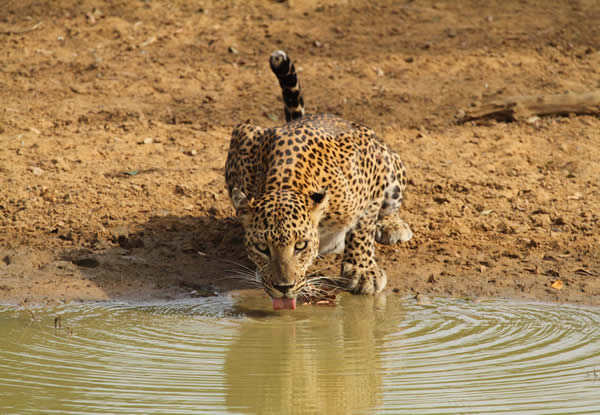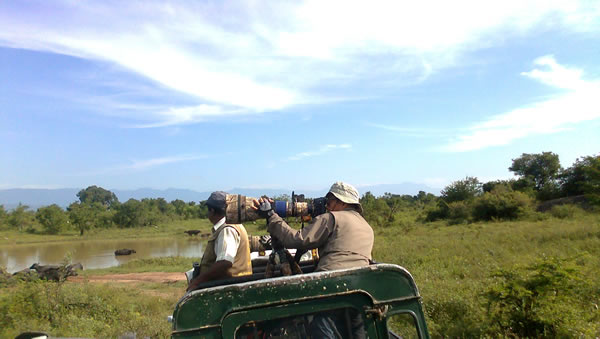Wildlife & Safari Tours in Sri Lanka
Walk With Jith will expertly organize wildlife and safari tours in Sri Lanka for you. We have a top wildlife and birding guide team and more than a decade of experience.
Simply send us a one-line email with an enquiry for wildlife and safari tours. Then we will guide your with suggestions, advice, proposal itineraries, modifications and prices.
We prepare tailor-made tours to fit your dates, interests and budget. With well thought itineraries, best wildlife locations, fitting accommodation, reliable transportation, honest and expert advice, and attention to detail, tour organizing is hassle-free. Tour execution is seamless.
Duration:
10 - 14 days is best. But you can extend or reduce the number of days.
Price:
A 14-day tour would start from 900 GBP (1400 USD) per person. For more details, please enquire.
Group size:
Individual, two people and small groups of up to 10 is best.
We, ourselves do not organize fixed date group tours.
What is special about Wildlife and Safari tours compared to other types of tours?
- We mainly focus on safari animals. Three of Sri Lanka's big five game animals 1. Asian elephant 2. Leopard and 3. sloth bear, and if you wish 4. blue whale and 5. sperm whale are in this list.
- Deer, wild buffaloes, jackals, mongoose, and monkeys are the other safari animals.
- Dolphins are also among the marine mammals.
- Reptiles such as crocodiles are also in the focus.
- The prolific birdlife in Sri Lanka, especially in Sinharaja is not missed.
- Insects such as butterflies and dragonflies are also seen in abundance.
- Wildlife and Safari tours will have more jeep drives than other tours. The tours can include many visit to variety of National Parks and Nature reserves in Sri Lanka, such as the Yala National Park. And you will spend more time in each, than in a normal tour.
- Cultural and the heritage site visits are not our focus. But you will definitely experience them as an added bonus during the tours. But of course, we will make sure that you experience the best and delicious Sri Lankan food in every location you visit.
Why Sri Lanka for Safari?
Gehan de Silva Wijeyeratne explains the supporting facts for the bold claim "Sri Lanka is the best all-round wildlife destination in the world"

Leopard at Yala National Park - photo from Nancy Van Gelder and Jeroen Dam
Best time to visit:
Generally, any time of the year is OK to Safari. Choose your time considering the specific species that you are targeting.
From May to October is the dry season in most National Parks. We consider this as the best time to watch (and photograph) especially leopards, elephants and other animals there. Also, This is the best time to see elephant gatherings in Minneriya National Park, and to watch or photograph leopards in Yala National Park.
(But please note, in the recent past years Yala National Park was closed in September. )
Sri Lanka is a tropical county. So throughout the year is good for birding. There are geat chances to see all 33 endemics any time of the year. But if you come between October to end of March you can see migrant birds as well.
If you are interested in marine mammals, we recommend the South Coast of Sri Lanka, especially for Blue Whales and Sperm Whales. Of course, Dolphins would also be there. And the best time to visit is November to April.
Top wildlife and Safari sites in Sri Lanka we visit
-
Yala NP
Yala national park is Sri Lanka’s oldest and most famous National Park, comprising of a diversity of habitats including scrub jungles, water reservoirs, brackish lagoons and riverine habitats.
Mugger and Estuarine Crocodiles frequent the riverbank. In the southern sector of the park, plenty of Tufted Grey Langurs will be found, as one watch eagerly for mammals such as Sambar and Spotted Deer. Leopards are probably easier to see here than anywhere else in Asia, and Yala is world famous for its large population of this most beautiful ‘big cat’. Sloth Bear is also common in the park, but less easily seen. Asian Elephants and wild boars will make into tour tick listThese are the bird highlights in Yala: Indian Pea Fowl, Black necked, Painted, Wooly necked and Adjutant Storks, Blue faced Malkoha, Malabar Pied Hornbill, Greater Flamingo (M), Brahminy Myna (M), Rosy Starling (M), Southern Sirkeer,
The beautiful early morning sunrises at the coastal boundary and other scenic areas are interesting attractions for photographers.
From a Wildlife tour in Sri Lanka...
Sloth Bear - photo by Phillip Marriott -
Wilpattu National Park
This is one of the oldest and biggest national parks in Sri Lanka. This is the place for leopards and sloth bear sightings. The unique feature of this park is the existence of "Willus" (Natural lakes) - Natural, sand-rimmed water basins or depressions that fill with rainwater. Located in the Northwest coast lowland dry zone of Sri Lanka.
Best time to visit: June to October -
Minneriya National Park
This park is located in the North Central province, close to Polonnaruwa and Sigiriya. It is a dry season feeding ground for the elephant population dwelling in forests of Matale, Polonnaruwa, and Trincomalee districts. This is called "The Gathering" and it is one of the top spectacular wildlife events in the world. There are many ideal opportunities to take elephant photos here.
Along with Kaudulla and Girithale, Minneriya forms one of the 70 Important Bird Areas (IBAs) of Sri Lanka.
The best time to visit is June to October -
Kaudulla National Park
Kaudulla National is located in the North Central province close to Minneriya park. The best time to visit the park is between June to October.
The main attraction here is also Elephants (including herds of juvenile males) there are gatherings too. Good photography opportunities are there. This is also a very good place for spotting birds. -
Kumana National Park
Kumana is renowned for its birdlife, particularly its large flocks of migratory waterfowl and wading birds. It is a paradise for wildlife photographers. Kumana is contiguous with Yala National Park and was formerly known as Yala East National Park.
Here it is possible to see leopards and you can also see wild elephants.Best time to visit: May to October
-
Horton Plains National Park
Horton Plains National Park is a protected area in the central highlands of Sri Lanka and is covered by montane grassland and cloud forest. Here vehicles are not allowed and this the only National Park that you have to walk.
Best time to visit: March to August.Species: Leopards are there but not easy to spot them. Sambar Deer, Barking Deer, Highland Toque Monkey, Highland Giant Squirrel and Highland Dusky Squirrel are seen here but the Highland Race of Purple faced Leaf Monkey (widely known as Bear Monkey) is the highlight among them.
Also if anybody like to see lizard this is the best place to see Sri Lanka endemic Rhino Horn Lizard and Black cheek lizard.
-
Udawalawa National Park
Udawalawa National Park lies on the boundary of Sabaragamuwa and Uva Provinces, in Sri Lanka. Udawalawe is an important habitat for water birds and Sri Lankan elephants. It is a popular tourist destination and the third most visited park in the country.
Best time to visit: all year around. -
Wasgamuwa National Park
Wasgamuwa is one of protected areas where Sri Lankan Elephants can be seen in large herds. It is also one of the Important Bird Areas in Sri Lanka. The name of the Wasgamuwa has derived through the words "Walas Gamuwa"."Walasa" is Sinhala for sloth bear and "Gamuwa" means a wood
-
Sinharaja Rain Forest
Sinharaja world heritage rain forest is the last remaining significant primary forest patch in the island. It is called Sinharaja Man & Biosphere Reserve and is home to most endemic flora & fauna species. This is the single most important site in Sri Lanka in terms of endemic birds and encounter spectacular mixed feeding flocks of birds.
This forest in the wet zone has an extensive bird list includes most of the country’s endemics and we have a good chance of seeing the majority of them, although some are easier to find than others. The ground-dwelling Sri Lanka Spurfowl requires stealth and sharp eyes, whereas roving flocks of Ashy-headed Laughing Thrushes and Orange-billed Babblers are much more obliging. Ceylon Hill-Mynas call loudly and clearly from exposed positions while Ceylon Hanging-parrots shriek past.
Purple faced leaf monkey, Wet zone race of Giant squirrel, Leopards are there but very difficult to spot, Sri Lanka Endemic Layard's Squirrel, Wet zone race of Taque Monkey.
Highlight birds – Green billed Caucal (E), Red faced Malkoha (E), Sri Lanka Blue Magpie (E), White faced Starling (E), Orange billed Babbler (E), Ashy headed Laughing Thrush (E), White throated Flowerpecker (E), Sri Lanka Myna (E), Sri Lanka Spur Fowl (E), Serendib Scops Owl (E), Brown capped Babbler (E), Scaly Thrush (E), Spot winged Thrush (E), Sri Lanka Crested Drongo (E) to name just a few endemics.
If you want to know more about Best Bird Watching Sites in Sri Lanka read our Bird Watching Tour page.

FAQ
- What is the difference between your birdwatching tours and wildlife & safari tours?
Of course, you will never miss birds in the wildlife and safari tours. After all, birds too are wildlife.
All our wildlife and safari tour guides are specialists in birdwatching too.
In a birdwatching tour, the focus is on birdwatching; tally counting, checklists. So, we spend more time in birding sites more than game sites. As an example, in a normal birding tour, we may do a full or half-a-day jeep safari in a place like Yala National Park. But in Wild life and safari tours we recommend at least two full days or more in Yala National Park.
- What about camping?
Camping inside National Parks is not allowed in Sri Lanka. It is a government rules. All of the camping sites are outside the National Parks. Camping is expensive. So normally in our tours we do not include camping sites in our accommodation places. If there are special requests we can definitely organize camping.
- Can we include whale watching?
Definitely yes. The best whale watching site is Mirissa in the South coast. Whale watching is seasonal; between November to April.
- Do you facilitate photography?
Yes, of course. Please see our Wildlife, Bird and Nature Photography Tour page.
- I heard Yala is crowded with tourists and jeeps at times. Is that true?
Yes, some times it is the case and our expert guides knows this.
Yala is the most famous and most visited national park in Sri Lanka. Lot of ordinary tourists visit there especially to see leopards and elephants. When we organize a wildlife jeep safari in the Yala National Park, we focus on overall wildlife inside the park, not only on elephants and leopards. We use good, experienced jeep drivers too. We always try to avoid traffic and go to more isolated, calm and quite areas to watch wild life. Also we drive very slowly and give good enough time inside the forest to spot and photograph animals.
- What are the best site in Sri Lanka to see and photograph leopards?
Yala National Park is the best place for leopard watching and photographing. It has one of the highest leopard densities in the world. But Wilpattu National park is the second best place leopard watching and there are chances in Kumana National Park too.
- What is the best site in Sri Lanka to see and photograph sloth bear?
Sloth bear is the most difficult animal to encounter form the Big Five in Sri Lanka Game Safari. From our experience, the most probable place to encounter the bear is Yala. There may be good chances in Wilpattu National park too.
- What is the best TIME to see leopards in Sri Lanka?
May to November is the best time. This is the dry season and they come near water sources.
- What is the best TIME to see sloth bear in Sri Lanka?
June and July are the best months when they occasionally venture out in the day to eat the seasonal palu and weera fruit. Sloth bears are nocturnal animals. So during the rest of the year they are rarely seen during the daytime and usually at dusk and dawn would be the best time to spot them.
Extensions: Culture, beach stay.
This tour can be modified for professional photographers' needs. See our Bird, Wildlife and Nature Photography Tours in Sri Lanka If you are a keen birder, a photographer, touring with your family or coming for honeymoon, note that we can customize this tour to fit your requirements.
You can extend this tour with visit to cultural and World Heritage Archaeological Sites. In this tour, preferably at the end, you can be a relaxing in a tropical sandy beach as per your wish.
Transport
We have our fleet of vehicles for tours; All, air conditioned and comfortable.
Two persons: cars or micro vans
2 – 4 person: micro vans.
More than 4: mini coach and buses
In national parks we use 4 wheel drive jeeps.
Wildlife and Safari Tour Guide
Our tour guides are friendly, Sri Lankan, well experienced and has a very good knowledge of overall wildlife of Sri Lanka, wildlife sites and National Parks. All our guides are licensed tour guides from the Tourist Board of Sri Lanka. Walk With Jith's guides will also use the services of local tour guides, villagers in certain places.
See our Tour Guides profiles and About Us page.
Why choose Walk With Jith for your safari?
Excellent reviews
In our tour reviews we have been highly commended for expertly planning and smooth execution of tours. And since 2006, on ResponsibleTravel.com we have 4.5 to 5 star ratings.
- Reviews on Sri Lanka Birding Trip Reports
- Reviews and testimonials on Walk With Jith website.
- Reviews on ResponsibleTravel.com
Recognized
We are recognized as a Bird Friendly Facilitator for more than a decade by the top birding organization, the Field Ornithology Group of Sri Lanka. For the last 10 years, Walk With Jith has been present at the British Bird Watching Fair.
Benefits of being local
We are local. We live here and we know Sri Lanka well. We ourselves are passionate travelers who travel to all locations and accommodation places. We keep up-to-date with news and reviews on the locations and accommodation places, so that we can offer you our honest, informed and unbiased advice.
Financial safety
We operate with trusted banking facilities of NatWest in the UK.
Catering exactly to your specific needs; time and budget.
We don’t organize fix date tours. We listen to and probe your very specific requirement. And provide tailor-made tours.
Economic responsibility
We ensure that the money you spend will directly and positively affect people at the village level. We seek to improve the lives of the people who affect & conserve habitats by buying products and services from them especially, guiding services.
Social responsibility
We make sure that the travelers also interact more with the locals, rather than with commercialized businesses. By doing so we hope that there is valuable knowledge sharing and inter-cultural linking, beneficial for both you and the locals.

